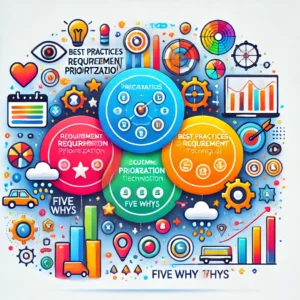Artificial Intelligence (AI) is revolutionizing various industries, and business analysis is no exception. AI-driven tools help business analysts improve efficiency, automate processes, and make data-driven decisions. In this article, we will explore how AI can be used in business analysis, the best AI tools available, AI-powered analytics, and certifications to boost your career in AI-driven business analysis.

How Can AI Be Used in Business Analysis?
AI can enhance business analysis in multiple ways:
- Data Processing and Analysis: AI-powered tools quickly analyze large datasets, identifying patterns and trends that might take humans much longer to uncover.
- Predictive Analytics: AI enables predictive modeling, helping businesses forecast market trends and customer behavior.
- Automation of Repetitive Tasks: AI chatbots and RPA (Robotic Process Automation) streamline data entry, report generation, and other manual tasks.
- Sentiment Analysis: AI-driven natural language processing (NLP) tools assess customer feedback, social media trends, and reviews to provide valuable insights.
- Decision Support Systems: AI integrates with business intelligence tools to provide real-time recommendations based on data analysis.
What is the Best AI Tool for Business Analysis?
The choice of an AI tool depends on business needs. Here are some of the best AI-driven business analysis tools:
- Power BI with AI Insights – Helps with data visualization and predictive analytics.
- Tableau with Einstein AI – Uses AI-driven insights for decision-making.
- ChatGPT and Bard AI – Assist in data analysis and report writing.
- IBM Watson Analytics – Provides AI-powered predictive analytics.
- Alteryx – Automates data preparation and analytics workflows.
- DataRobot – Enables AI-powered predictive modeling.
- RapidMiner – A no-code AI tool for business analytics.
How is AI Used as a Business Tool?
AI enhances various business functions, including:
- Customer Relationship Management (CRM): AI-based tools like Salesforce Einstein optimize customer interactions.
- Risk Assessment: AI algorithms predict financial risks and fraud patterns.
- Marketing and Sales: AI analyzes customer preferences to personalize campaigns.
- Supply Chain Optimization: AI predicts demand and automates logistics management.
- Human Resources: AI-driven recruitment tools analyze resumes and predict candidate suitability.
What are AI Analytics Tools?
AI analytics tools process vast amounts of data to provide actionable insights. Some popular tools include:
- Google Analytics with AI – Tracks website performance with AI-driven insights.
- SAS Analytics – Provides advanced predictive analytics.
- Microsoft Azure Machine Learning – AI-powered data analysis platform.
- BigML – AI-driven predictive analytics tool.
- TensorFlow – Open-source AI tool for deep learning analytics.
Free AI Tools for Business Analysts
If you’re starting with AI in business analysis, consider these free tools:
- Google Colab – Free cloud-based AI and machine learning tool.
- Hugging Face – Offers free NLP models for text analysis.
- AutoML by Google Cloud – Provides AI-powered data insights.
- Orange Data Mining – Free AI tool for data visualization.
- KNIME – Open-source analytics tool for data processing.
AI Business Analyst Course and Certification
To advance in AI-driven business analysis, consider these certifications:
- IBM AI Business Analyst Certification – Covers AI applications in business analysis.
- Google Data Analytics Professional Certificate – AI-powered business analytics training.
- IIBA AI in Business Analysis Certification – Industry-recognized AI certification.
- MIT AI for Business Strategy Course – Advanced AI-driven business strategies.
- Coursera’s AI for Business – AI applications in business analysis.
Generative AI for Business Analysts
Generative AI tools like ChatGPT and Jasper AI help business analysts with:
- Automated Report Writing: AI generates business reports and summaries.
- Data Interpretation: AI assists in data storytelling and visualization.
- Scenario Analysis: AI models predict different business scenarios.
- Stakeholder Communication: AI-driven chatbots improve collaboration.
AI Business Analyst Salary
AI-driven business analysts earn competitive salaries due to their specialized skills. Here’s an approximate salary breakdown:
- Entry-Level AI Business Analyst: $70,000 – $90,000 per year.
- Mid-Level AI Business Analyst: $90,000 – $120,000 per year.
- Senior AI Business Analyst: $120,000 – $150,000 per year.
- Freelance AI Business Analysts: Earn $50 – $100 per hour.
Salaries vary based on experience, location, and industry. (For more insights, check industry salary reports on Glassdoor or LinkedIn Salary.)
AI for Business Analysis: The Future
The future of AI in business analysis looks promising with:
- Enhanced AI-Powered BI Tools – AI-driven decision-making will become standard.
- Real-Time Predictive Analysis – AI will provide real-time insights for businesses.
- AI-Driven Process Automation – More business functions will be automated.
- Advanced AI Chatbots – AI-powered assistants will handle stakeholder communication.
Internal and External Resources
- Internal Links:
- Learn more about Business Process Modeling Techniques.
- Explore Agile Methodology for Business Analysts.
- External Links:
- Check out Google AI for AI-powered tools.
- Discover IBM Watson for AI-driven business insights.
Conclusion
AI is reshaping business analysis by automating tasks, improving efficiency, and providing data-driven insights. By leveraging AI-powered tools, business analysts can make informed decisions, optimize processes, and stay ahead in the competitive landscape. Investing in AI courses and certifications will help professionals upskill and advance in their careers.
Do you use AI in business analysis? Share your thoughts in the comments below!

Business Analyst , Functional Consultant, Provide Training on Business Analysis and SDLC Methodologies.




